This year there will be about 20 major biennials and triennials around the world, on average one every two to three weeks. The art world jet-setters that fill this raucous circuit, hopping from Sao Paulo to Sydney to Shanghai -- all of which hosted biennials this year -- can be a Fellini-like cast: vainglorious, vapid and very full of themselves. The biggest biennial of them all is Venice, and reviews from the last one (held in 2001) spent as much time discussing the Prada shoes of the gallery-goers as the works of art.
American artist and educator, Rita McBride, sneered as she said, "I try to stay away from [the biennial circuit]. I find it disgusting."
Thursday night's opening of the 2002 Taipei Biennial did not seem to aspire to the dolce vita, even though Taipei's past biennials have. It only attracted a moderate sampling of the art world A-list: curators, museum directors, critics and 27 of the 31 artists in the show. By then, a few of the artists had even marked the absence of social functions, like Runa Islam, who'd been in Taipei almost a week by opening night and was at that point saying, "It'd be nice to go out for a drink or something."
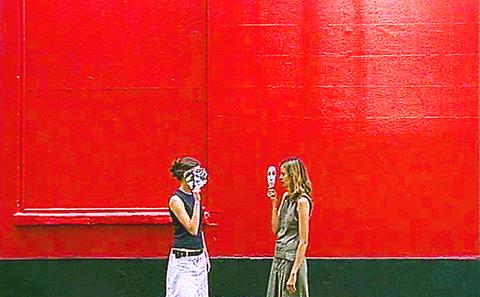
PHOTO COURTESY OF TFAM
However, there was still Thierry Raspail, artistic director of the Biennale de Lyon, one of the major European biennials to take place next year, who strode through the museum corridors saying, "I'm here because I think this show is important." And there were many others there for the same reason.
The exhibition, organized under the theme Great Theatre of the World, is curated by Bartomeu Mari of Spain with Taiwan's Jason Wang (王嘉驥) and runs through March 3, 2003 at the Taipei Fine Arts Museum. In the high profile and highly competitive international biennial scene, it takes an idiosyncratically serious attitude.
The muted demeanor marks a change from past TFAM biennials, which took heavy cues from the international exhibition circuit. The museum's first internationalized biennial came in 1998, when the museum hired Nanjo Fumio, a top independent curator in Japan, to put it on the international map. Surrounding the museum with bamboo billboards and rerouting interior flows, Nanjo deconstructed and reconstructed the museum into a flashy, sexy show called Site of Desire.
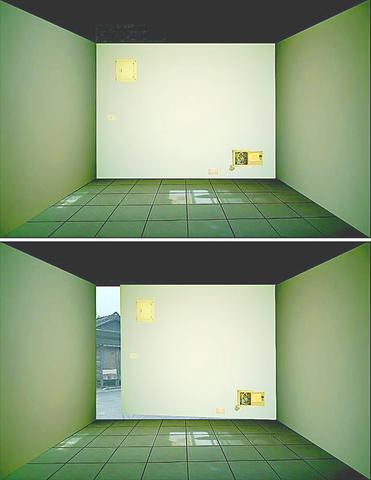
PHOTO COURTESY OF TFAM
"It was very influential on the local arts scene. It really set the imprint for subsequent local exhibitions to follow, said Wang, who admits the influence in his own curating.
Two years ago, the museum teamed a well known French curator, Jerome Sans, with a local curator, Manray Hsu (
This year, the job for Bartomeu and Wang, according to TFAM director Huang Tsai-lang (
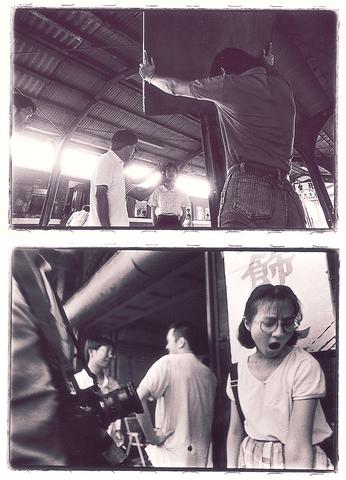
PHOTO COURTESY OF TFAM
Huang, who's headed the museum for only about a year, made no other demands, giving curators complete freedom from quotas and political concerns.
"Our goal is to be known as a biennial in Asia, not an Asian biennial, he said.
So the austerity and the gravity this year come from the curatorial decisions. One involved the formal character of the works, almost two-thirds of which are two-dimensional of 31 artists, 13 work with video and another nine in flat media like photography or painting. Art on the walls and movie theatres -- it's an uncharacteristically classical approach to contemporary art. And the intensity of classical viewing is amplified by the museum's building, which was not reorganized as in years past.
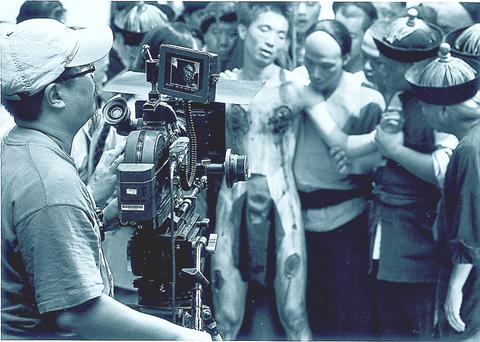
PHOTO COURTESY OF TFAM
Built in 1983, TFAM is a minimalist assemblage of square white tunnels that Taipei Museum of Contemporary Art director Leon Paroissien once called "horrible," "formalist," and "static." Its regimental attitudes towards showing art are strongly present in this year's show.
But there is a gravity of spirit as well, one Wang sees as related to the sobriety of world events. "Two years ago, there was a lot more optimism. We didn't find that this time," he said.
Many works take on tones that range from soured to austere, a far cry from the carefree consumerist buzz and playing irony common a year or two ago. American Tony Brown's video installation shows a giant baby's head taunted by a dancing and very unhappy happy-face. Taiwan's Chen Chieh-ren's (
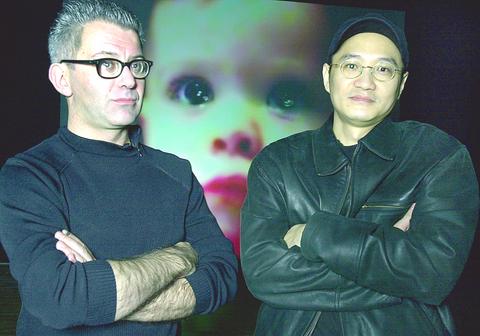
PHOTO: CHIANG YING-YING, TAIPEI TIMES
The consistency of temperament comes from a group of artists with an unusually wide generational span. The youngest are 29. Hungarian Nicolas Schoffer died ten years ago. The oldest present at the opening was Joan Jonas, age 66. It is not the typical biennial collection of fresh, young artists with something to prove.
Works also tend to be recent, with a few pieces showing for the first time. It was a coup for curators who had only five months to prepare an exhibition. Islam, of her 22 minute film, Rapid Eye Movement, said, "I was just finishing it and looking for a place to show it in August when Bartomeu called. It worked out perfectly."
German artist Johannes Kahrs was also approached by Mari with a special request, to create a visual script of his sketches and notes, objects for him usually more part of the process than the finished product.
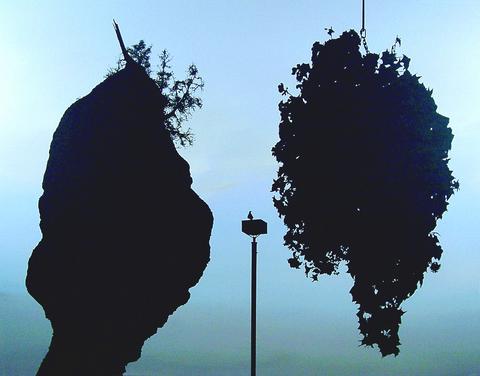
PHOTO COURTESY OF TFAM
"I usually don't show my work like this. It's the stuff I usually keep in the studio, but Bartomeu asked me to do it like this," Kahrs said.
But then there is McBride, who's Arena has toured so long she said, "I'd just like to see it die on the road, to fall off a shipping container or something."
There are circuit regulars like Edwin Zwakman, Thomas Demand and the Dutch collective MVRDV. Many of the Chinese and Taiwanese artists, who are considered "national exports" by their home governments and use biennials as a primary means of exposure to the western markets where they sell, are also biennial regulars.
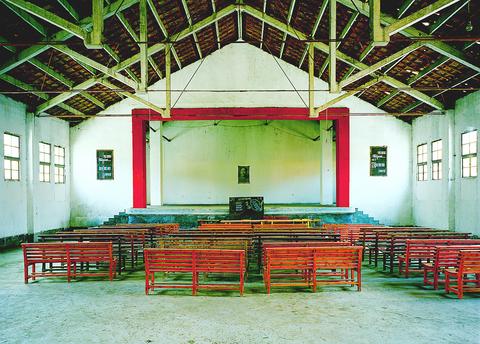
PHOTO COURTESY OF TFAM
It as an interesting mix, but as the visiting Italian critic, Pier Luigi Tazzi, observed, "I was in Shanghai [for the Shanghai Biennial] last week, but there the selection was random. This is much better. There is a strength and a consistency of the ideas."
The center of the consistency is the theme, Great Theatre of the World. The show begins with McBride's Arena, a four-meter tall set of bleachers dominating the large entrance room. They face the entrance, implying that the stage, or what is to be viewed, is actually the outside world.
"Some people in the museum wanted it the other way [facing the museum], but if I turned it the other way, the museum becomes the stage," she said.

In the March 9 edition of the Taipei Times a piece by Ninon Godefroy ran with the headine “The quiet, gentle rhythm of Taiwan.” It started with the line “Taiwan is a small, humble place. There is no Eiffel Tower, no pyramids — no singular attraction that draws the world’s attention.” I laughed out loud at that. This was out of no disrespect for the author or the piece, which made some interesting analogies and good points about how both Din Tai Fung’s and Taiwan Semiconductor Manufacturing Co’s (TSMC, 台積電) meticulous attention to detail and quality are not quite up to
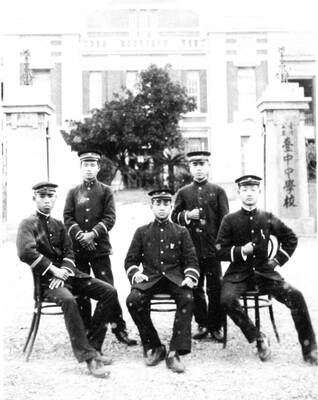
April 28 to May 4 During the Japanese colonial era, a city’s “first” high school typically served Japanese students, while Taiwanese attended the “second” high school. Only in Taichung was this reversed. That’s because when Taichung First High School opened its doors on May 1, 1915 to serve Taiwanese students who were previously barred from secondary education, it was the only high school in town. Former principal Hideo Azukisawa threatened to quit when the government in 1922 attempted to transfer the “first” designation to a new local high school for Japanese students, leading to this unusual situation. Prior to the Taichung First

Chinese Nationalist Party (KMT) Chairman Eric Chu (朱立倫) hatched a bold plan to charge forward and seize the initiative when he held a protest in front of the Taipei City Prosecutors’ Office. Though risky, because illegal, its success would help tackle at least six problems facing both himself and the KMT. What he did not see coming was Taipei Mayor Chiang Wan-an (將萬安) tripping him up out of the gate. In spite of Chu being the most consequential and successful KMT chairman since the early 2010s — arguably saving the party from financial ruin and restoring its electoral viability —

The Ministry of Education last month proposed a nationwide ban on mobile devices in schools, aiming to curb concerns over student phone addiction. Under the revised regulation, which will take effect in August, teachers and schools will be required to collect mobile devices — including phones, laptops and wearables devices — for safekeeping during school hours, unless they are being used for educational purposes. For Chang Fong-ching (張鳳琴), the ban will have a positive impact. “It’s a good move,” says the professor in the department of